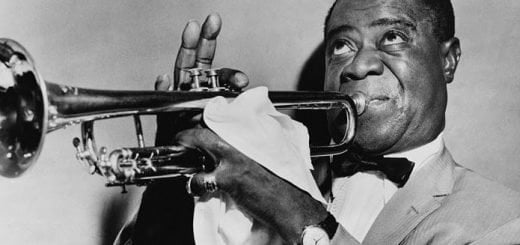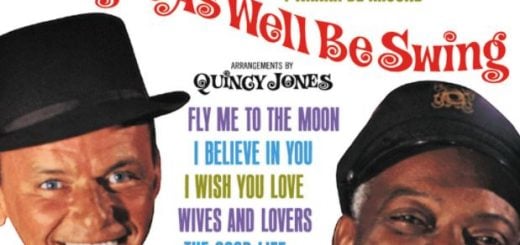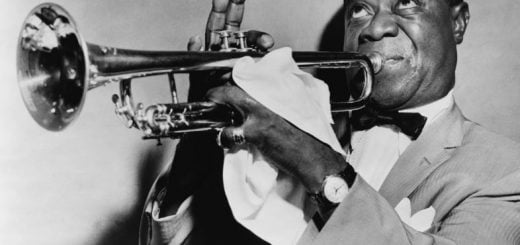“La Vie En Rose” by Louis Armstrong
Anytime we cover these songs from the mid-20th century, the reader should keep in mind that when they were composed right after – or in this case during World War II. That may be why, more than being say practical reflections of life itself, they generally tend to be somewhat idealistic in nature.
Take for instance “La Vie en Rose”. The title, literally translated to English, comes out to “Life in Pink”. But a more accurate translation, in terms of how the titular phrase is actually used in conversation, would be akin to something like “life through rose-colored glasses”.
Or as implied earlier, the lyrics of this song are jolly, shall we say. And even more specifically, the implication is that they pertain to romance, as in the singer addressing his lover. But that being said, they are still quite effective in getting his profound love for this lady across.
Or in getting down to the nitty-gritty, the singer experiences the aforementioned perception whenever he is spending intimate time with the addressee. That is to say that this is one of those types of love songs where the vocalist is expressing how much his life, overall, is edified by his sweetheart. Or let’s say that when they’re not together, to him the world is like normal. But when they do hook up “roses bloom”, and when she speaks “angels sing from above”. Indeed words which have no significant meaning otherwise “turn into love songs” when emitted from her lips.

Conclusion
So the conclusive sentiment features the narrator entreating this lady to devote herself to him forevermore. For if so, then he believes that his ‘life will be in pink’ always.
Who wrote “La Vie En Rose”?
The writers of this song were all French musicians – Louiguy (1916-1991), Marguerite Monnot (1903-1961) and Édith Piaf (1915-1963). That is to say, as the title suggests, that “La Vie en Rose” was originally composed in French. And it was Piaf who not only wrote the lyrics but also laid down the original recording of the tune in 1947.
Different Versions
Whereas the tune proved to be Édith Piaf’s signature song, it was also quite popular in the United States. In fact seven different versions, which were recorded by primarily American artists during 1950, all managed to chart (with the lyrics being translated by Mack David, 1912-1993).
They were, in order of Billboard chart success, by the following:
- Tony Martin (9)
- Paul Weston (12)
- Bing Crosby (13)
- Édith Piaf (23)
- Ralph Flanagan (27)
- Victor Young (27)
- Louis Armstrong (28)
And Louie Armstrong (1901-1971) dropped his version via Decca Records.
Grace Jones also released her own cover in 1977 which proved to be a notable hit, especially in Italy. Lady Gaga performed this song for her 2018 film “A Star Is Born”. Other stateside artists who have covered it include:
- Shirley Bassey
- Luciano Pavarotti
- Liza Minnelli
- Julio Iglesias
- Josephine Baker
- Dean Martin
- Audrey Hepburn
And overall the tune proved popular enough to be the recipient of a 1988 Grammy Hall of Fame Award.
Louis Armstrong’s Version of “La Vie En Rose”
Louis Armstrong recorded his version alongside Sy Oliver (1910-1988) and his orchestra. In fact during 1950 these fellow Decca artists recorded two songs together which originated in France, having laid down a cover of C’est Si Bon in addition to La Vie en Rose. In fact the former was apparently released as the B-side (or double A-side) of the latter.
And according to the story behind the song, it was Decca Records who instructed Armstrong to record “La Vie en Rose”, as he had proven to be really successful at covering tunes.
Moreover for the record, the other musicians who participated on the official recording of this track were the following trumpeters:
- Bernie Privin (1919-1999)
- Paul Webster (1909-1966)
- Melvin Solomon (circa 1913-2003)
The song’s trombonist is Morton Bullman (d. 2003).
The song’s saxophonists are as follows:
- Art Drelinger (1915-2001)
- Bill Holcombe (1924-2010)
- Hymie Schertzer (1909-1977)
- Milt Yaner (1911-1985)
The other musicians who played on it are: pianist Earl Hines (1903-1983), drummer John Blowers (1911-2006), guitarist Everett Barksdale (1910-1986) and bassist George Duvivier (1920-1985).
Louis Armstrong’s cover is considered to be his signature song outside of “What a Wonderful World” (1967). This is partially evident in the vast number of films and television shows it has made appearances on, even well into the 21st century. Some notable names on that list include WALL·E (2008), Gotham (2016) and Dolemite Is My Name (2019).









Thank you! That was extremely informative and very much appreciated.
An amazing song, if you have the opportunity watch Rachael Leahcar perform it on the voice